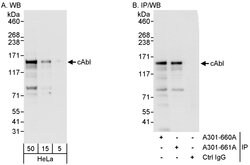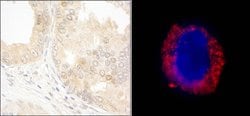Learn More
cAbl Rabbit anti-Human, Polyclonal, Bethyl Laboratories
Rabbit Polyclonal Antibody
Supplier: Bethyl Laboratories, Inc A301660A

Description
The recommended shelf life for this product is 1 year from date of receipt.
c-Abl (Abelson murine leukemia viral oncogene homolog 1, ABL1) is a 140 kDa proto-oncogene member of the Src family of non-receptor tyrosine kinases. c-Abl has been implicated in processes of cell differentiation, cell division, cell adhesion, and stress response. Activity of c-Abl protein is negatively regulated by its SH3 domain, and deletion of the SH3 domain turns c-Abl into an oncogene. The t(9;22) translocation results in the head-to-tail fusion of the BCR and c-Abl genes present in many cases of chronic myelogeneous leukemia. The DNA-binding activity of the ubiquitously expressed ABL1 tyrosine kinase is regulated by CDC2-mediated phosphorylation, suggesting a cell cycle function for c-Abl. In chronic myelogenous leukemia and a subset of acute lymphoblastic leukemias, the c-Abl proto oncogene undergoes a (9;22) chromosomal translocation producing a novel rearranged chromosome (the Philadelphia chromosome) As the result of the fusion of c-Abl sequences from chromosome 9 to the Bcr gene on chromosome 22. The molecular consequence of this translocation is the generation of a chimeric Bcr/Abl mRNA encoding activated Abl protein tyrosine kinase. The c-Abl oncogene was initially identified as the viral transforming gene of Abelson murine leukemia virus (A-MuLV). The major translational product of c-Abl has been identified as a protein with tyrosine kinase activity and an SH2 domain. The c-Abl oncogene is implicated in several human leukemias including 90-95% of chronic myelocytic leukemia (CML), 20-25% of adult acute lymphoblastic leukemia (ALL) and 2-5% of pediatric ALL. c-Abl localizes to dynamic actin structures, and phosphorylates CRK and CRKL, DOK1, and other proteins controlling cytoskeleton dynamics. c-ABL potentially regulates DNA repair by activating the proapoptotic pathway when the DNA damage is too severe to be repaired.Specifications
| cAbl | |
| Polyclonal | |
| Unconjugated | |
| ABL1 | |
| RP11-83J21.1, ABL, JTK7, bcr/abl, c-ABL, p150, v-abl | |
| Rabbit | |
| Antigen affinity chromatography | |
| RUO | |
| 25 | |
| 4° C | |
| Liquid |
| Immunocytochemistry, Immunofluorescence, Immunohistochemistry, Immunoprecipitation, Western Blot | |
| 0.2 mg/ml | |
| TBS with 0.1% BSA and 0.09% sodium azide | |
| P00519 | |
| ABL1 | |
| Between 550 and 600 | |
| 100 μL | |
| Primary | |
| Human | |
| Antibody | |
| IgG |
The Fisher Scientific Encompass Program offers items which are not part of our distribution portfolio. These products typically do not have pictures or detailed descriptions. However, we are committed to improving your shopping experience. Please use the form below to provide feedback related to the content on this product.

